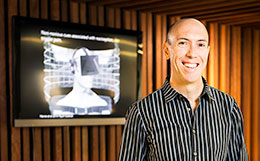29 July 2016
 A new study lead by UniSA’s Body in Mind research group, soon to be published in the Official Journal of the American Pain Society, the Journal of Pain, shows human pain thresholds can be influenced by classical conditioning, or associative learning.
A new study lead by UniSA’s Body in Mind research group, soon to be published in the Official Journal of the American Pain Society, the Journal of Pain, shows human pain thresholds can be influenced by classical conditioning, or associative learning.
While previous evidence has shown that fear of pain can be acquired by classical conditioning Tory Madden, PhD student, and UniSA Professor of Clinical Neurosciences and Chair in Physiotherapy, Lorimer Moseley, have now shown pain thresholds can be modulated via classical conditioning, even when the stimulus used to test the threshold cannot be anticipated.
This research is a major breakthrough because it shows pain can be learnt and events, that are not truly dangerous, can automatically trigger pain.
Professor Moseley says the discovery is particularly relevant for understanding the persistence of pain after tissue healing.
“When one stimulus, let’s say a noxious stimulus, is repeatedly paired with another stimulus, let’s say a movement so that the movement starts to trigger the pain even when the noxious stimulus is no longer present, then classical conditioning has occurred,” Prof Moseley says.
“This process has often been proposed as a potential cause of persistent pain but has not been shown - until now.
“The way classical conditioning might relate to the typical persistent back pain patient is straight forward - a person who repeatedly experiences pain when bending forward after a back injury may continue to experience pain on bending forward, even after the injured tissues have healed and the sensory nervous system's response to harmful or potentially harmful stimuli has ceased or returned to baseline levels – that is, the movement is no longer truly harmful, but it still hurts.
“This research lays a critical foundation for further investigations of classical conditioning as a possible driver of persistent pain and because we have shown pain can be learnt via association we can attempt to reduce pain by uncoupling the association in a careful way.
“Pain is a huge problem, affecting one in five people and costing western societies about as much as diabetes and cancer combined, so this development in our understanding of pain and how it can be ‘learnt’ takes a significant step towards better prevention and treatment of persistent pain and may end up leading to new treatments altogether.”
With ‘You look good - how do you feel?’ currently the theme of Chronic Pain Australia’s National Pain Week, Prof Moseley says pain is something individuals feel very specifically and because this research provides important insight into the connection between the mind and the body when it comes to feeling pain, it helps to explain why some people recover from pain differently.
“Pain is an experience and cannot be separated from the patient's psychological, environmental, contextual and cultural situation and while psychological and educational treatments are already the mainstay for chronic pain rehabilitation, this research raises the possibility of more tailored aspects to treatment,” he says.
“This discovery is an important addition to a rapidly growing body of literature that shows very clearly, that pain is about protection, not about marking the state of the tissues of your body.
“Pain is a ‘perceptual inference’ based on the likely benefit of protective behaviour - not a measure of tissue damage so to treat and prevent chronic pain we need to consider everything relevant to protection, not just the state of the tissues of your body.
“On the basis of our discoveries we are now investigating classical conditioning in real life situations and other groups around the world are starting to do the same.
“While we haven’t got a cure here for chronic pain this research takes us one step closer to a potentially transformative discovery - that an important reason your brain protects you by producing pain when the tissues are not actually in danger may lie in sensory pathways that are very trainable.
"This means, if we end up being correct, we will have a new and better way to prevent chronic pain.”
Professor Lorimer Moseley
Professor Moseley is the Chair of PainAdelaide Stakeholders' Consortium, which runs outreach activities such as the Ride for Pain and PainAdelaide Scientific meeting and leads the Body in Mind Research Group, based at the University of South Australia and at Neuroscience Research Australia, in Sydney. The Body in Mind research group undertakes clinical intervention studies and clinical trials of treatments for defined chronic pain conditions in both healthy volunteers and people in pain.
The study details
Led by Tory Madden and in association with Dr Daniel Harvie from Griffith University and Professor Johan Vlaeyen from Ku Leuven, Belgium, the experiment delivered tactile stimuli at two different locations. One location was associated with a very painful stimulus. These stimulus trials are called the acquisition period. After the acquisition period, pain threshold was tested with repeated stimuli coupled with the original tactile stimuli. The testing phase clearly showed that pain threshold was lowered or raised according to the relationships established during the acquisition period. The timing of the two stimuli - the noxious one and the tactile one - was such that the effect could not be explained by expectation but was instead, an instantaneous response.
Media contact: Katrina McLachlan Office +08 83020961 Mob 0419815443 Email katrina.mclachlan@unisa.edu.au




